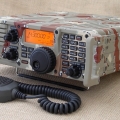TX near the kiwi
Hello
What is the safe distance of the kiwisdr for me to transmit with 100 watts ??
THankyou
RIck from South Am?rica
What is the safe distance of the kiwisdr for me to transmit with 100 watts ??
THankyou
RIck from South Am?rica

Comments
It's not a specifically easy question to answer, as there are a few factors in play. If the RX antenna is a small loop, with the null average pointed at your dipole antenna, then the distance could be quite small. But it you've got an OCFD tx and a longwire rx in parallel then you're going to need more distance.
Assume the antennas are too close for safe use of a 100W transmitter at unknown frequency and act accordingly.
The reception will be wiped out anyway so just drop it, if you want something off the shelf there are item for sale (E.G. MFJ-1708SDR)
There other threads on here about protecting the front end, for example back to back signal diodes (most easily fitted to the green anntenna ports), smal signal lamp as fuse, that would be worth doing straight away as the impact on reception will be minimal but it could save your Kiwi.
40 dB below 1 kW is 100 mW and not enough power to damage protection parts, either external or even those within the Kiwi, I suspect.
Lightning strikes may be another matter all together...